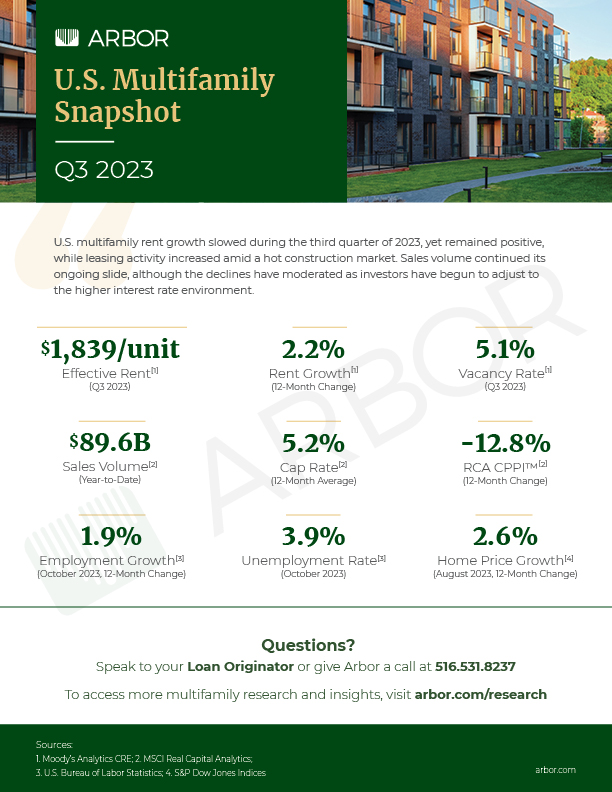U.S. Multifamily Market Snapshot — Q3 2023

The U.S. multifamily market held steady during the third quarter of 2023, as high mortgage rates and a lack of inventory in the housing market continued to drive rental demand.
Multifamily rent growth decelerated compared with the skyrocketing highs of the last two years, although it remained positive. According to Moody’s Analytics CRE, the average asking rent in the U.S was up 2.2% year over year, although lower than the 11.1% growth rate reported one year ago, and the lowest since 2021. The vacancy rate in the third quarter finished at 5.1%, slightly higher than the 4.8% rate reported at the end of the third quarter of 2022, although it remained near historical lows. Net absorption was able to surpass the pace of new completions during the quarter for the first time since the second quarter of 2022, as the rapid pace of new construction finally began to show signs of slowing.
Construction delays were reported by 88% of respondents in the latest Quarterly Survey of Construction & Development Activity from the National Multifamily Housing Council (NMHC). Of those, 79% reported experiencing permitting delays, up from 70% in the prior quarter, while delays in starts remained relatively constant at 79%. The NMHC also reported that apartment market conditions, in general, continued to weaken during the quarter with all four components of the Quarterly Survey of Apartment Market Conditions coming in well below the breakeven level.
Apartment investment activity continued to slow during the third quarter, as the gap between buyers and sellers remained wide, although MSCI Real Capital Analytics points out that asset sales have begun to show signs of moderating as investors adjust to the higher interest rate environment. Sales volume reached $89.6 billion through the first three quarters of the year, which was well below the $251.9 billion recorded through the same time period during 2022 and on pace for the lowest annual total in nearly a decade. The average cap rate rose sharply to 5.2%, up from 4.6% one year ago, despite the limited activity. The RCA CPPI™ for the apartment sector fell 12.8% year over year, the largest annual decline among major property types, although the monthly decline has been easing since the start of the year.
The U.S. job market posted its 34th consecutive month of payroll gains in July, as the unemployment rate remained near 50-year lows. Wage growth slowed to 4.1% year over year, while the number of job openings remained elevated.
The housing market continues to show few signs of life amid supply pressure, affordability constraints, and high interest rates. Home prices have fallen slightly since their 2022 peak, although increased in August for the seventh consecutive month, according to S&P CoreLogic’s latest Case-Shiller U.S. National Home Price NSA Index. The index was up 2.6% year over year in August, more than doubling July’s 1.0% increase.
Here’s a look at the U.S. multifamily finance and investment key benchmarks for Q3 2023.
Interested in the multifamily real estate investment market? Contact Arbor today to learn about our array of multifamily, single-family rental, and affordable housing financing options. Don’t miss our other market research articles, and our latest reports can be found in our research section.


